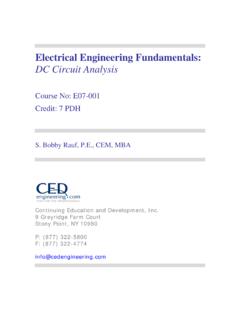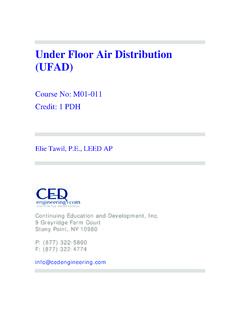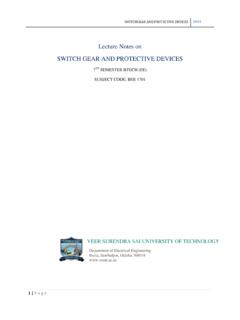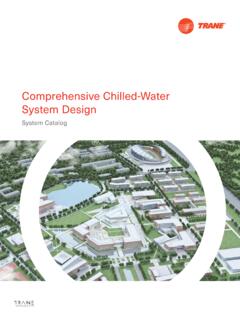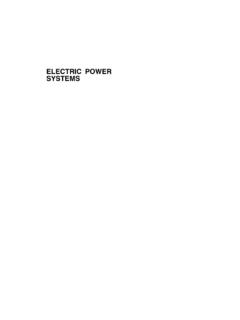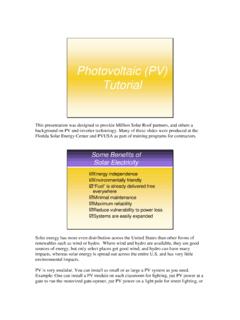Transcription of Basic Electrical Engineering for HVAC Engineers
1 Basic Electrical Engineering for HVAC Engineers Course No: E04-025. Credit: 4 PDH. A. Bhatia Continuing Education and Development, Inc. 9 Greyridge Farm Court Stony Point, NY 10980. P: (877) 322-5800. F: (877) 322-4774. Basic Electrical Engineering FOR HVAC Engineers . A heating, ventilating and air-conditioning (HVAC) system is a simple system of heating and cooling exchangers using water or refrigerant (direct expansion system) as the medium. Pumps move the heated or cooled water to the exchangers. Fans then move the warmed or cooled air created at the exchangers to the occupied building interiors. So there are two stages to heating and cooling 1.
2 Water stage: water is the most efficient and inexpensive medium that we can cool directly (through a chiller) or heat (through a boiler). 2. Air stage: air is the medium for heat exchange in the building as it can be cooled or heated through coils. The figure below illustrates a typical HVAC system showing water and air heat exchangers: Big energy users in HVAC. 1. Fans: for air circulation and ventilation. 2. Cooling: accomplished via chillers for the production of chilled water for large buildings or for the use of direct expansion cooling systems such as packaged air-conditioners for small buildings. 3. Heating: most frequently the energy use of boilers for the production of hot water for heating, but also often the use of electric heaters for zonal reheat.
3 4. Pumps: for the circulation of heating hot water, chilled water and condenser water. 5. Cooling towers: for heat rejection. The primary energy use is the cooling tower fan and pumps. Power distribution systems and equipment used to drive HVAC machinery, motors and other auxiliaries can be complex to the non- Electrical engineer. This course will address some Basic Electrical concepts that will be useful to HVAC Engineers and other mechanical Engineers in their day to day work. The course is divided in 4 sections: Part -1: Basic Electrical Concepts & fundamentals Part -2: Electrical Distribution Systems and Components Part -3: Motors and Variable Speed Drives Part -4: Electrical Energy Efficiency in HVAC Systems PART -1: Basic Electrical fundamentals .
4 In each plant, the mechanical movement of different equipment is caused by an electric prime mover (motor). Electrical power is derived from either utilities or internal generators and is distributed through transformers to deliver usable voltage levels. Electricity is found in two common forms: 1. AC (alternating current). 2. DC (direct current). The selection of an energy source for equipment depends on its application, each having its own merits and demerits, but for an HVAC system or typical building services, we are concerned with AC voltage. Industrial AC voltage levels are roughly defined as LV (low voltage) and HV (high voltage) with frequency of 50 to 60 Hz.
5 An Electrical circuit has the following three Basic components irrespective of its Electrical energy form: 1. Voltage (V) is defined as the Electrical potential difference that causes electrons to flow. 2. Current (I) is defined as the flow of electrons and is measured in amperes. 3. Resistance (R) is defined as the opposition to the flow of electrons and is measured in ohms. All three are bound together with Ohm's law, which gives the following relation between the three: V=I R. In a more technical expression, you can state it as: With Constant Resistance Lower voltage gives small current. Higher voltage gives large current.
6 With Constant Voltage Lower resistance passes large current. Higher resistance passes small current. Example: A conductor has a resistance of ohms and the current flowing on the wire is 5. amperes. The voltage drop along the wire will be the current times the resistance of the conductor or volts. Example: A resistance type heating element from an electric water heater operating at 240. volts has a current flow of amperes. The resistance of the heating element will be the voltage divided by the current or ohms. CIRCUITS. In order to flow, electricity must have a continuous, closed path from start to finish; like a circle. The word circuit refers to the entire course an electric current travels, from the source of power, through an Electrical device, and back to the source.
7 Every circuit is comprised of three major components: 1. A conductive "path," such as a wire, or printed etches on a circuit board;. 2. A "source" of Electrical power, such as a battery or household wall outlet; and 3. A "load" that needs Electrical power to operate, such as a lamp. The current flows to the devices (called loads) through a hot wire and returns via a neutral . wire because under normal conditions it's maintained at zero volts, or what is referred to as ground potential. There are also two optional components that can be included in an Electrical circuit. These are control devices and protective devices. Control and protective devices, however, are not required for a circuit to function.
8 They are optional. For example, a circuit that switches on an air conditioner when the temperature is too high would contain the following components: a source of Electrical energy, in this case, simple household current;. a protective device that senses current flow on the circuit, the circuit breaker in the panel box;. a control device that redirects the current, the switch in the thermostat; and a load such as an air conditioner that cools the space down until the circuit opens shutting the air conditioner off. Types of Circuits: There are several types of circuits. Their names describe the way the circuit is wired, or its main function.
9 Elementary types of circuits include: Series Parallel Open Short Power Control Series Circuit: A series circuit is defined as a circuit in which the elements in a series carry the same current, while voltage drop across each may be different. It has only one path for current to flow through the circuit. A typical series circuit is shown below: Here are the Basic rules of a series circuit. Current: In a series circuit the current (I) in amperes is the same everywhere in the circuit. IT= I1 = I2 = I3. Voltage: The total voltage of the circuit will be the sum of the voltages across each of the resistors in the circuit. VT = V1 + V2+ V3.
10 Resistance: The total resistance of the circuit will be the sum of the individual resistors in the circuit. RT = R1 + R2 + R3. Parallel Circuit: A parallel circuit is defined as a circuit in which the elements in parallel have the same voltage, but the currents may be different. It has multiple paths for the current to follow as shown in the figure below: Basic Rules Voltage: The voltage will be the same across all resistors in the circuit and it will be equal to the supply voltage. VT = V1 = V2 = V3. Current: The total current (I) in amperes flowing in the circuit will be the sum of the currents through each parallel branch of the circuit.

